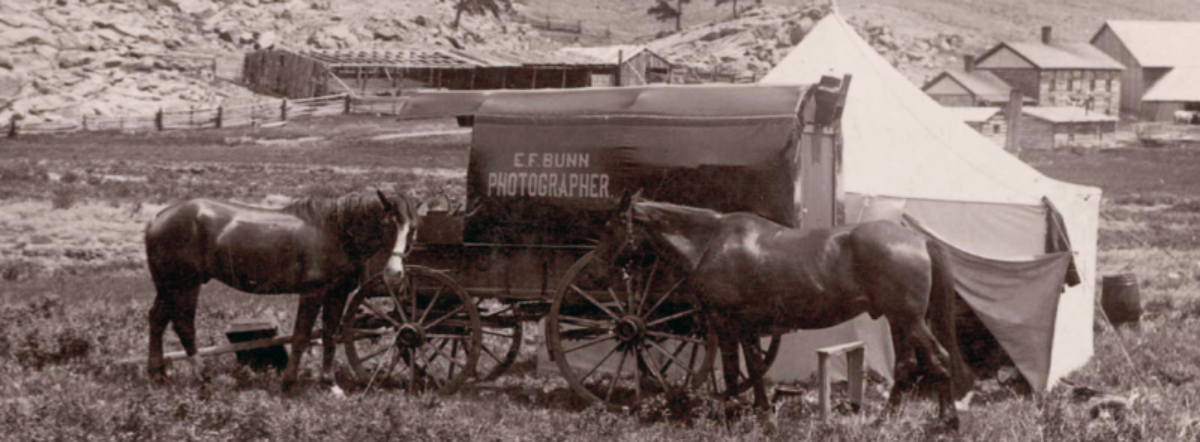Fort Morgan, the county seat of Morgan County, is known as “The Capital of the Plains.” Originally a stop along the Overland Trail, Abner S. Baker platted the town on May 1, 1884, In the late 1800s, the city’s population never reached 700. Traveling photographers or photographers who juggled more than one profession to make ends meet, served the needs of the community. Profiles for 19th century photographers active in Fort Morgan are below. Do you know of any I missed?

Frank E. Baker (1849-1939), a photographer from Greeley, Colorado opened branch galleries in Fort Morgan and Loveland in the early 1890s. A biographical sketch of Baker will appear in a later post about Greeley.
Baker’s tender cabinet card portrait of two well-dressed children suggests that the child on the left may have been a difficult subject to photograph. The child holds a doll and a partially eaten apple, while holding onto a hand from a hidden family member trying to comfort the young child.
Boy S. Bohn was born in Germany in December 1861. Trained as a photographer in his native country, Bohn departed Hamburg, Germany on the Patria and arrived in New York City on December 26, 1895. He may have worked in St. Louis, Missouri, before joining photographer F. W. Webster in Des Moines, Iowa in 1899. In April 1900, Jacob O. Brown employed Bohn in his studio. By June 1900, Bohn resided in Medicine Creek, Nebraska, continuing to work in the photographic field. His life after 1900 is undocumented.

Jacob O. Brown was born on January 12, 1871 north of Syracuse in Parish, New York to Isaac and Isabelle Brown. By 1880, the family was living in St. Paul, Nebraska.
In 1886, J. O. Brown operated a bicycle repair shop in Fort Morgan, Colorado. After his marriage to Lettie M. Worrell in 1897, Brown opened a barber shop. The first mention of Brown’s photographic work appeared in the February 4, 1898 issue of The Fort Morgan Times, an occupation he often practiced in addition to the tonsorial art. Later that year he purchased a 6-1/2 x 8-1/2” camera, wanting to photograph animals and outdoor scenes, in addition to portraits. He also made stamp photographs. Stamp photographs were made by copying an image onto multiple stamp-sized perforated and gummed photo paper. Each image measuring only 3/4 x 1.”

In November 1899, Brown acquired a new photo tent. He held a contest to name the new studio, selecting “The Elite Gallery” as the winning entry. In the spring of 1900, he hired German-born photographer Boy Bohn to work in his gallery for a short time. Brown expanded his barber shop in 1902 and also opened an ice cream factory. Brown left Colorado for the West Coast. By 1914 he had settled in Tacoma, Washington, continuing to work as a photographer and barber. By 1920 he resided in Salem, Oregon. He died on July 1,1934 and his remains rest in Idlewilde Cemetery, Hood River, Oregon.
Crescent Gallery–See T. H. Madden
Elite Gallery–See J. O. Brown

J. E. Evans was active as a photographer in Fort Morgan and vicinity in 1898.
Field was an unidentified traveling photographer active in Fort Morgan in 1889.
Harrington & Son
A partnership of Josiah Henry Harrington and his son Orville C. Harrington. As traveling photographers, they worked in Fort Morgan in 1888.

Thomas Henry Madden was born in Clay, Illinois to John Thomas Madden and Ann Maria Pfaff. In 1869, he married Leah L. Buzick in Richland County, IL. He worked as a day laborer and wagon maker.
By 1884 Madden ran a photography gallery in Ashland, Nebraska. A decade later he settled in Fort Morgan, Colorado, making outdoor views and portraits. Concurrently, he grew crops on his farm on the south fork of the Republican River. By the fall of 1896 Madden worked full-time as a photographer. The following year, The Fort Morgan Times reported that Madden planned to go on the road with a well equipped, horse-drawn traveling photograph gallery. Madden and J. Clark Silance spent three months photographing eastern Colorado. When they returned, Madden continued on his own to work in the small towns on the eastern plains, including Brush and Sterling. Later, he took his family to Nebraska where he carried on business under the name “Crescent Gallery.”
In 1899, Madden’s operation was located opposite McComb’s livery stable in Fort Morgan. He offered 25 stamp photographs for 25 cents.
Madden ran his Fort Morgan studio until about 1908. In 1918, two weeks after undergoing an operation, Thomas Henry Madden died on April 3, 1918. His remains rest at Fort Morgan’s Riverside Cemetery.
Madden & Silance, a partnership between Thomas H. Madden and J. Clark Silance, worked in Fort Morgan during 1897.
J. Clark Silance was born in Ohio in April 1867. He grew up in Nebraska. By 1896, Silance settled in Fort Morgan, Colorado. Between May and August 1897, Silance traveled with T. H. Madden through eastern Colorado in Madden’s horse-drawn studio on wheels. After leaving Madden’s employment, Silance raised livestock. By the early 1920s, he lived in the Santa Monica area. On September 28, 1935, Silance suffered a fatal heart attack in an orchard in California’s River Farms district.
With thanks to Brian Mack, Museum Curator, Fort Morgan Library and Museum for providing research assistance and access to the museum’s collections, and The Peter E. Palmquist Memorial Fund for Historical Photographic Research for providing travel funds.
